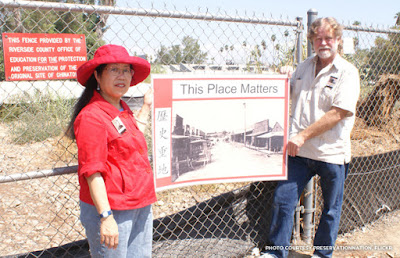The National Trust for Historic Preservation has included descriptions of several significant historic sites for Chinese.
Julia Morgan, the famed architect of the iconic Hearst Castle, also designed the Chinese YWCA building (1932) in San Francisco, now the home of the Chinese Historical Society of America (CHSA).
Here is an excerpt from an interview with Director Sue Lee recorded at the CHSA in 201
Here is an excerpt from an interview with Director Sue Lee recorded at the CHSA in 201

Artist Rene Yung researched San Francisco Bay Area’s once-thriving Chinese shrimp fishing community. She boarded the Grace Quan, a replica of a 19th-century shrimp fishing junk, and sailed around the Bay retracing the steps of these early fishermen whose stories have largely been lost.
Using the images and sounds captured on this journey, she combined them with information gathered from scientists, ecologists, archaeologists, historians, and others to create a visual record of the history, Chinese Whispers: Bay Chronicles, an immersive multimedia installation on display at the San Francisco Maritime National Historical Park visitor center.
The Mississippi Delta Chinese Heritage Museum features an exhibit of artifacts re-assembled to look like an authentic Chinese grocery. Wong hopes that eventually, the museum might be a free-standing building, “a place for research and education.”
A historic marker celebrated the Cleveland Chinese Mission School in Cleveland, MS. that served Chinese students during the days of segregation in the South, from 1937 until 1951, and was repurposed as the Chinese Baptist Church before being demolished in 2003.
Seattle’s Chinatown Historic District boasts a state-of-the-art museum in the circa-1910 East Kong Yick Building. Named for the first Asian American in the Pacific Northwest to hold elected office, the Wing Luke Museum, or “The Wing,” was founded to “preserve and share the experiences, histories, and contributions of pan-Asian Pacific Americans.”
Located in the Kam Wah Chung State Heritage Site in John Day, Oregon, and originally constructed as a trading post in the 1860s, the Kam Wah Chung building served as a “commercial, social, and cultural center for the Chinese community in eastern Oregon” from 1887 until the 1940s. It housed an informal medical treatment room and pharmacy, a general store, a library and a post office. Today, a museum located in the original building displays hundreds of artifacts from the late 19th to the mid-20th century.
From 1910 to 1940, the Angel Island Immigration Station in San Francisco bay processed up to one million Asian and other immigrants, including 250,000 Chinese and 150,000 Japanese people, earning it the reputation of being the “Ellis Island of the West.”
Today, the U.S. Immigration Station Barracks Museum allows visitors to explore the station’s grounds, including exhibits highlighting historic photographs, artifacts, and a re-creation of immigration living quarters and interrogation rooms.
The first Chinese pioneers arrived in Riverside around 1870. By 1885, the Chinatown area was flourishing with 450 permanent residents and as many as 2,500 migrant workers providing skilled labor to a growing citrus industry.
But over the years, the town’s population fell dramatically, and by 1943 only one resident remained. Then, in the mid-1970s, fire destroyed several buildings and the rest were demolished to make way for commercial development. Today, all that remains of this once-vibrant culture are remnants of buried buildings and other artifacts that lie underground.
People everywhere are coming together to protect this important part of the community’s heritage, working towards a goal of establishing a Chinatown Memorial Park. Rosalind Sagura co-founded and currently serves as chair of the Save Our Chinatown Committee and created a strong network of local advocates and organizations, students, and a whole
Arkansas had a small Chinese population of laborers in the 1870s brought to work on plantations but they soon opened small family-run grocery stores in the Arkansas Delta in the southeast corner of the state. Few Chinese are left but one of the grocery store owners, Frank Chu, donated the vacant storefront of his grocery store for a future museum of Chinese in Arkansas.
Arkansas had a small Chinese population of laborers in the 1870s brought to work on plantations but they soon opened small family-run grocery stores in the Arkansas Delta in the southeast corner of the state. Few Chinese are left but one of the grocery store owners, Frank Chu, donated the vacant storefront of his grocery store for a future museum of Chinese in Arkansas.









No comments:
Post a Comment